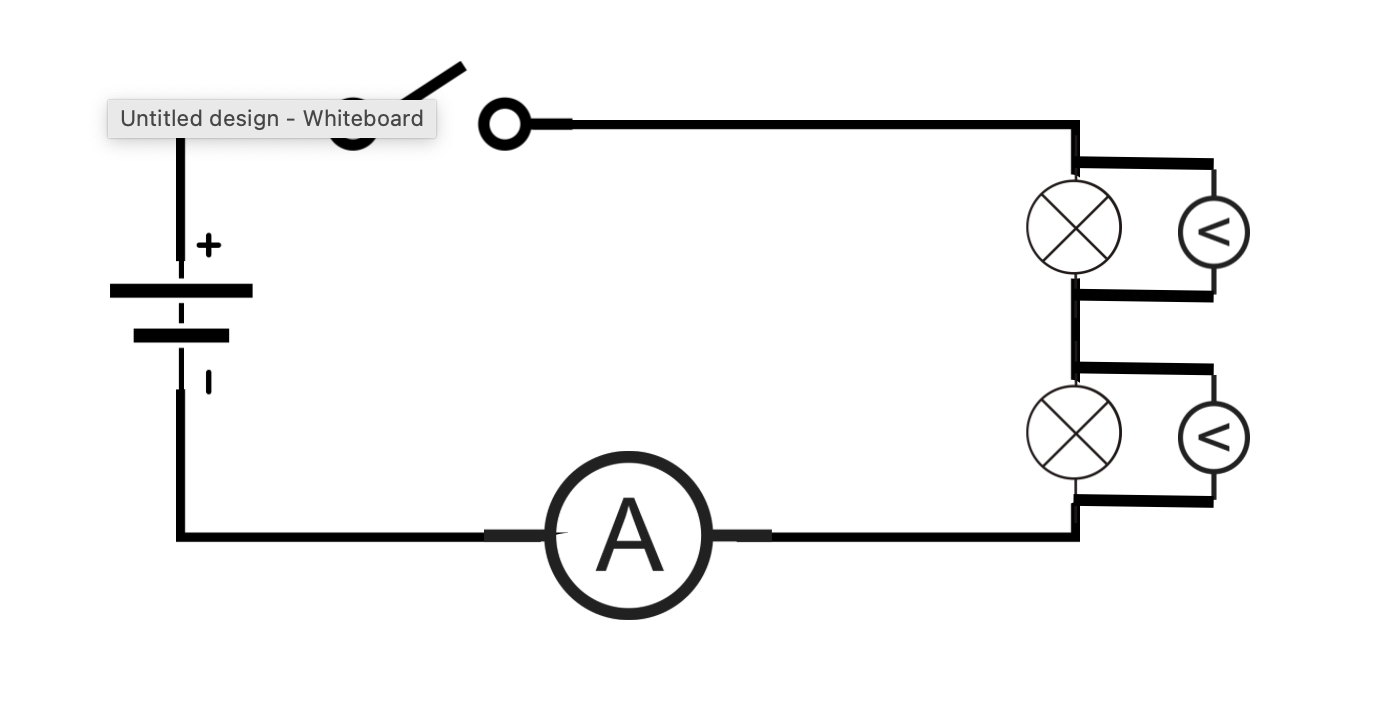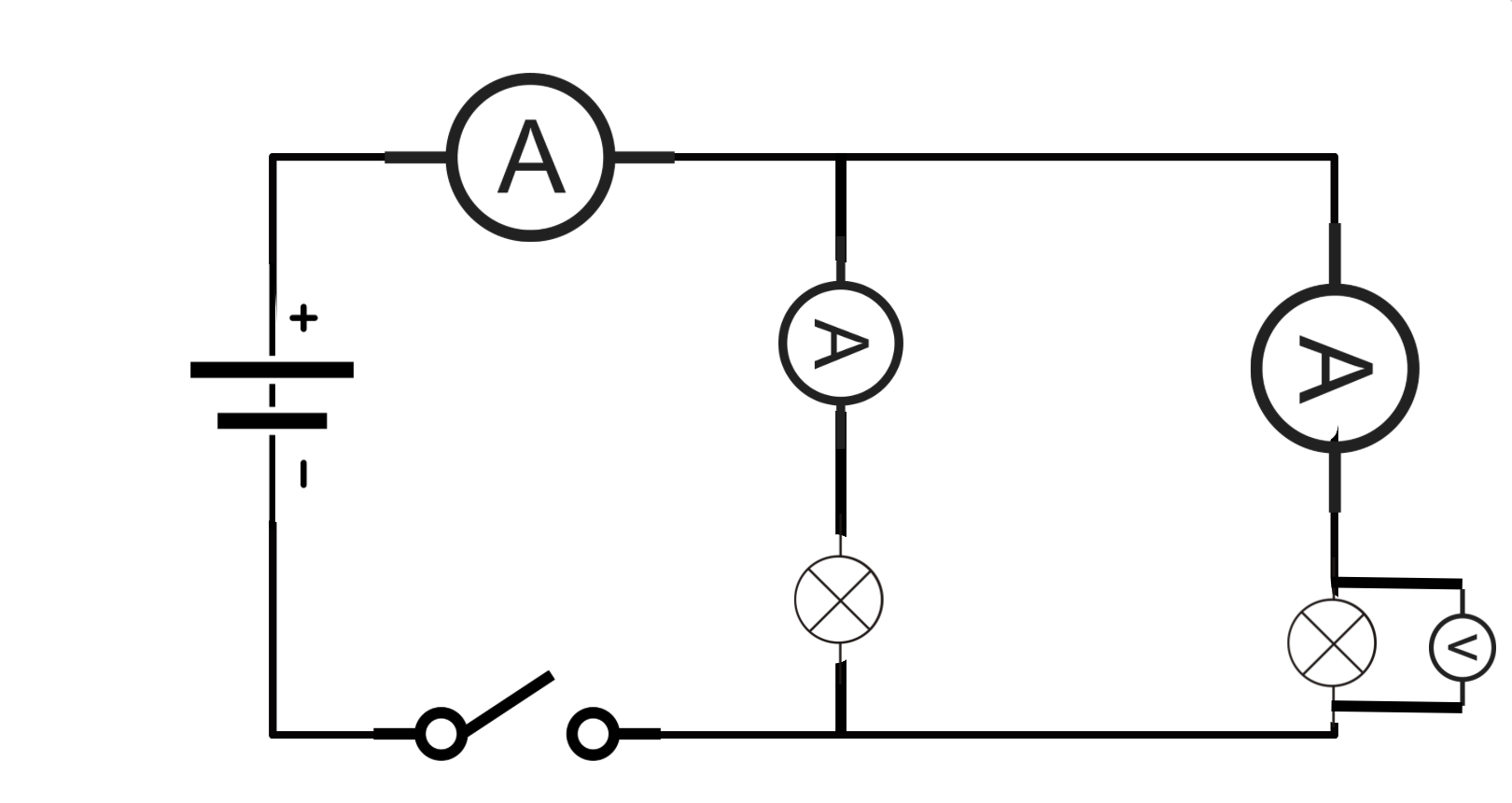Physics 9
Basics
Parts of a Circuit
Battery/source: gives energy to coulombs
Conductor: Passes coulombs
Switch: controls flow of coulombs
Can be placed anywhere
Insulator: Does not pass coulombs
Ammeter: counts coulombs per second
Connected in series
Measures current through the units of amp
Counts coulombs per second
Voltmeter: Measures change in energy per coulomb
Connected in parallel
Measures potential energy using volts
Joules per coulomb
Resistor: Takes energy from columbus and converts it into heat as current passes through, following Ohm's Law.
Eg. Light bulbs, motors, or electrical heaters
Questions
Circuit: a chain that conducts coulombs
Current/Amperage: Flow of coulombs per second
Flow is equal everywhere in the circuit
Voltage is the energy change per coulombs, calculating joules per colomb, potential difference, and push.
Energy gained at battery is the energy released by the bulb
Short circuit: A battery connected without resistors that causes coulombs to flow too fast and overheats.
Series Circuits
Using this diagram:

Questions
When two bulbs are connected in series, the amperage will be the same.
The voltage across each bulb will be half of the battery’s voltage.
If we ignore the meters, there is one path for the electrons to move around the circuit.
If one light bulb burns out, the electric current will go to zero and the brightness of each bulb will go out.
We can control the bulbs by placing the switch anywhere in the circuit.
Meter Readings
Say the battery provides 6 amperes and 12 volts.
The two volt meters will read: 6V
The ammeter will read 6A
Quiz Questions
In any series circuit, the amperage within the circuit is the same no matter where you measure it.
In a series circuit containing:
One bulb, the voltage is equal to the voltage of the battery.
Two identical bulbs, the voltage drops across each bulb to one half.
Three identical bulbs, the voltage drops to one third of the total voltage.
As you connect more bulbs in a series,
The brightness of each bulb decreases.
The size of the current decreases.
The number of paths for the current increases.
In a series circuit, if one light bulb burns out,
The current goes to zero
The brightness of the remaining bulbs go to zero.
Fuses act like switches to open if a short circuit occurs. Fuses must be connected in series.
Switches are connected in series to what they control in the circuit.
Ammeters are connected in series to what they are measuring the current through.
What type of meter is connected in series? Ammeter.
Parallel Circuits
Using this diagram:

When bulbs are connected side by side so the current divides at a branch point, it is called a parallel circuit.
In the above parallel circuit, what should the voltage read if the battery gives 6V? 6V
What should the voltage of the other lightbulb be? 6V
If the voltage of each lightbulb is the same, the current is the same as well for each light bulb.
If the ammeters in each branch read 1, the total ammeter will read 2 because the total amperage is the sum of the equal readings of each branch.
If more bulbs are added, the brightness of the bulbs will remain the same.
IF more bulbs are added, the main ammeter’s reading will go up.
If more bulbs are connected, the amperage of each branch will remain the same.
If more bulbs are added, the number of paths for the current to flow will increase.
If one bulb goes out in a parallel circuit, the other bulbs will remain unaffected.
If one bulb goes out in a parallel circuit, the main ammeter will decrease.
If one bulb goes out in a parallel circuit, the current in the branch circuits will stay the same.
If one bulb goes out in a parallel circuit, the brightness of the remaining bulbs will stay the same.
Is there every a parallel circuit where one branch gets all the current while the other gets none? Only in a short circuit.
OHM’s Law
V = I x R
Problem 1: If the current (I) in a circuit is 3 amperes and the resistance (R) is 4 ohms, what is the voltage (V)?
Solution: V = 3A x 4Ω = 12VProblem 2: A circuit has a current of 5 amperes and the voltage is 20 volts. What is the resistance (R)?
Solution: R = V / I = 20V / 5A = 4ΩProblem 3: In a circuit with a voltage of 15 volts and a resistance of 3 ohms, what is the current (I)?
Solution: I = V / R = 15V / 3Ω = 5AProblem 4: If a circuit has a voltage of 24 volts and a current of 6 amperes, what is the resistance?
Solution: R = V / I = 24V / 6A = 4ΩProblem 5: A light bulb operates at 10 ohms of resistance and has a current of 2 amperes. What is the voltage across the bulb?
Solution: V = I x R = 2A x 10Ω = 20VP = I x V
Problem 1: If the current (I) in a circuit is 4 amperes and the voltage (V) is 10 volts, what is the power (P)?
Solution: P = 4A x 10V = 40WProblem 2: A device runs on a voltage of 12 volts and uses a current of 3 amperes. What is the power (P) it consumes?
Solution: P = 3A x 12V = 36WProblem 3: If a circuit has a power consumption of 60 watts and the voltage is 15 volts, what is the current (I)?
Solution: I = P / V = 60W / 15V = 4AProblem 4: A light bulb operates at 24 volts and consumes 2 amperes. What is the power it uses?
Solution: P = I x V = 2A x 24V = 48WProblem 5: If an appliance requires 100 watts of power and operates at 250 volts, what is the current (I) it draws?
Solution: I = P / V = 100W / 250V = 0.4AE = P x T
Problem 1: If a device consumes 100 watts of power (P) and is used for 3 hours (T), what is the energy (E) consumed?
Solution: E = P x T = 100W x 3h = 300WhProblem 2: A light bulb has a power rating of 60 watts and is used continuously for 5 hours. What is the total energy (E) used by the light bulb?
Solution: E = P x T = 60W x 5h = 300WhProblem 3: An appliance operates at 150 watts and runs for 2 hours. How much energy (E) does it consume?
Solution: E = P x T = 150W x 2h = 300WhProblem 4: If a power tool operates at 250 watts and is used for 4 hours, what is the energy (E) consumed?
Solution: E = P x T = 250W x 4h = 1000WhProblem 5: A heater has a power rating of 2000 watts and runs for 1.5 hours. What is the energy (E) used by the heater?
Solution: E = P x T = 2000W x 1.5h = 3000Wh